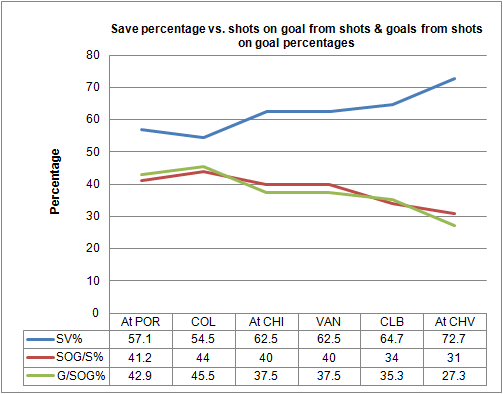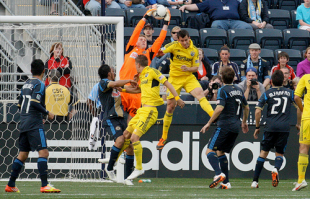Photo: Paul Rudderow
Zac MacMath recorded his third consecutive shutout on Saturday night, a feat never before accomplished by a Philadelphia Union goalkeeper. (The Union had back-to-back shutouts three times in 2011, twice with Faryd Mondragon and once with MacMath. They didn’t record a shutout in 2010 until Brad Knighton’s on September 11, the only other of the season coming 2 games later.) From a shaky start in 2012, MacMath’s current Goals Allowed Average of 1.00 puts him in a three-way tie for fifth lowest for keepers who have played six or more games. He is in a two-way tie for third for fewest goals allowed.
While the growth of his confidence between the posts is evident, he would be the first to admit that that confidence begins with a defense that has looked increasingly settled over the past three games. While this welcome development is no doubt connected to the abandonment of the three defender experiment that opened the season, it is also related to the repositioning of Brian Carroll to his natural spot in front of the back line and the return of Gabriel Farfan to the left back position. That this has coincided with the lineup adjustments of Sheanon Williams to the center and the start of rookie Raymon Gaddis that have been required due to the lingering injury to Danny Califf makes the turnaround even more remarkable.
Limiting dangerous shots
In the season opener, Portland recorded 17 goal attempts, 7 of which were on target. Of those 7 shots, 4 came from within the penalty area and 3 of those were goals. In the home opener against Colorado, 4 of the 8 goal attempts were on target, two of which were from the penalty area, both of which resulted in a goal. Of the 15 goal attempts recorded by Chicago, 5 were on target. Of those, 4 came from within the penalty area and one of those was a goal. On Saturday, Chivas USA had 21 goal attempts, 5 of which were on target. Only one came from within the goal area and it was saved. This was also the case against Columbus, who had only one shot on target, also from inside the penalty area, while Vancouver recorded no shots on target.
Every one of the six goals conceded by the Union in 2012 has come from within the penalty area. While it is certain that at some point someone will score against the Union from outside of the box, acknowledging that inevitability does not detract from the conclusion that, if you give an opponent opportunities to be on target close to goal, they will have a greater chance of scoring.
The success of the Union in decreasing the number of such chances over the last 3 games can be illustrated by looking at how the defense has consistently whittled away at opponents overall all shots on goal from shots (SOG/S) and goals from shots on goal (G/SOG) percentages over the first 6 matches of the season and the corresponding rise in MacMath’s save percentage. As we can see, there has been a 10 percentage point drop in opponents’ shots from shots on goal average and a 15-point drop in their goals from shots on goal percentage overall. The 15-point increase of MacMath’s save percentage follows the second trend. (Note: I calculated the percentages above using numbers from the Opta-powered chalkboards rather than the Stat pages found at the MatchCenter for each game at MLSsoccer.com. The Stat pages for the games in Portland and Chicago have 1 more shot on target than is recorded on the Chalkboard for each game.)
As we can see, there has been a 10 percentage point drop in opponents’ shots from shots on goal average and a 15-point drop in their goals from shots on goal percentage overall. The 15-point increase of MacMath’s save percentage follows the second trend. (Note: I calculated the percentages above using numbers from the Opta-powered chalkboards rather than the Stat pages found at the MatchCenter for each game at MLSsoccer.com. The Stat pages for the games in Portland and Chicago have 1 more shot on target than is recorded on the Chalkboard for each game.)
Keeping the pressure on
A measure of how the Union defense has been able to limit its opponents opportunities to create dangerous shots is the CBI average, which looks at combined defensive clearances, blocks and interceptions. In other words, the CBI looks at how well the Union defense keeps the pressure on its opponents’ attack.
Two teams leaking goals in the East are Toronto (13 goals allowed) and Montreal (15 goals allowed). Unsurprisingly, Toronto and Montreal have the worst and third worst CBI averages in the league at 26.33 and 35.88, respectively. Over all, the league average is 40.74. The Union comes in at 47.
(The information about CBI comes from a recent post on the league’s website that contains only a partial list of CBIs across the league, so I can’t say where the Union fall among those teams that have a better CBI than the average. I calculated the Union’s CBI by tallying numbers for the defender block, interception, clearance, and blocked cross categories in the defensive filter of the Chalkboard for each game. On the chance that the blocked cross category is not included in the MLSsoccer.com article calculations—and I bring this up only because that category isn’t specifically mentioned there—the Union’s CBI is still above the league average at 44.67.)
One way MacMath helps himself
In addition to being strong between the posts, MacMath has also has helped himself by being more accurate with his distribution out of the back.
After recording passing accuracy percentages below 50 percent in the first two games, MacMath has been much more accurate. In fact, his passing accuracy—and the total number of attempted passes includes long boots up field—has been better than that of some backline field players in three games, which you have to admit is pretty amazing. His 67.9 percent accuracy at Chicago topped Valdes’ 59.5 percent and Lopez’s 64.1 percent, and his accuracy percentage bested that of Garfan in the Vancouver and Chivas games (57.1 and 56.5 percent). In this way, MacMath helps himself by helping the Union to retain possession in the midfield (and, hopefully, transition into the attack).
Unfortunately, I have been unable to find passing numbers for other goalkeepers across the league so I cannot make a comparison. This is also the case when it comes to the accuracy of passes that cross the half-way line, the numbers for MacMath which are also recorded below. While they are more up and down than the passing accuracy numbers overall, the average of 41.5 percent seems encouraging, even if it is below the old “50-50 ball” cliche.



Comments